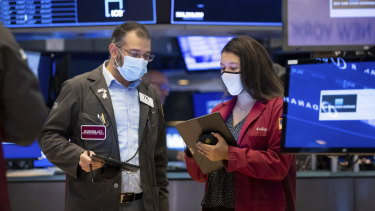
As the rebound in iron ore prices to solidly above $US200 a tonne (to about $US214 a tonne this week) has demonstrated, the efforts of the Chinese authorities have been less-than-successful to date.
That’s probably because demand for metals globally has swollen as unprecedented fiscal stimulus and surging consumer demand have driven quite dramatic economic recoveries.

The Fed’s assertion that the highest US inflation numbers for decades are a transitory phenomenon seems to have been accepted by financial markets.Credit:NYSE
The quickness and strength of the bouncebacks have caught companies – both producers and their customers – short of inventories, exacerbated the supply chain issues and increased the pressure on commodity prices.
The recent wobbling in the price might also have something to do with the uncertainty around monetary policies, particularly those of the US Federal Reserve Board.
Copper is highly correlated with economic and inflation (as “financialisation” of commodities has developed in recent decades it has been regarded as a good financial hedge against inflation) and therefore the succession of rising inflation numbers in the US and elsewhere may have been a factor in the surge in prices.
In recent weeks, however, the Fed’s assertion that the highest US inflation numbers for decades are a transitory phenomenon seems to have been accepted by financial markets, with bond yields falling back materially.
If significant decarbonisation of the global economy is to occur, demand for copper, the most widely and intensely used metal in “green” technologies, will soar.
The fading of the concern that the elevated inflation readings might force the Fed to reduce its bond and mortgage buying and raise US rates earlier than anticipated is probably a strand in the explanation for the loss of momentum in the copper price, although that could change overnight if the Fed were to signal any concern that the elevated inflation levels might not be fleeting.
Underpinning the copper price and providing some assurance that it won’t fall back to pre-pandemic levels is the increasing global commitment to lowering carbon emissions.
If significant decarbonisation of the global economy is to occur, demand for copper, the most widely and intensely used metal in “green” technologies, will soar.
Glencore’s retiring chief executive Ivan Glasenberg said last month that the price would need to be at least $US15,000 a tonne to encourage new production if the mining industry were to produce the extra million tonnes of metal needed to underwrite the merging developed world consensus of net zero carbon emissions by 2050.

Glencore’s retiring chief executive Ivan Glasenberg says the copper price would need to be at least $US15,000 a tonne to incentivise new production to meet demand.Credit:Bloomberg
The lack of investment by existing copper producers since the end of the last supercycle in metals a decade ago; declining production and trades at most of the existing big mines; reduced exploration and few new finds of real scale and the likelihood that any new large deposits that are discovered will be in difficult and quite risky jurisdictions (politically and geographically) act as constraints on new supply.
Scrap copper and substitutes with lower conductivity, like aluminium, may play a role in helping to meet demand and that demand could, of course, be affected in the near to medium term if the rebound in the global economy were to prove a false dawn.
The nature of the demand, is however changing and its base is broadening.
Where it was the commodity-intensive industrialisation of China and, to a lesser extent, other developing economies that drove the last metals super-cycle and China’s continuing infrastructure-intensive growth that provided a floor under demand in the past decade, decarbonisation is being led by the developed economies.
Demand for copper and the other metals vital to renewable technologies is growing strongly in Europe and the US, adding a long-term stream of additional demand to a market that will be increasingly short of supply.
It may be that in the longer term “Dr Copper” won’t just be an indicator of global economic health but a good way to track progress in global decarbonisation and climate health.
In the near term, however, it will be the former that will be most useful in providing insights into the sustainability of the economic recoveries in China, the US and Europe and, for the US in particular, acting as a real-time barometer of the inflation and interest rate outlook.
If the price remains elevated it would indicate the Fed has misjudged the resilience of a recovery that, in the US, might be sustained by the unprecedented spending plans of the Biden administration while it would also pose a threat to China’s ability to keep a lid on inflationary pressures that threaten its competitiveness and growth.
Loading
If it subsides, it would suggest that the boost to global growth from pandemic-inspired stimulus will be short-lived, that the acceleration in decarbonisation isn’t living up to developed world commitments and that and the world will retreat to the low-growth, low-inflation, low-rate environment of the decade before the pandemic struck.
The Market Recap newsletter is a wrap of the day’s trading. Get it each weekday afternoon.






 Add Category
Add Category